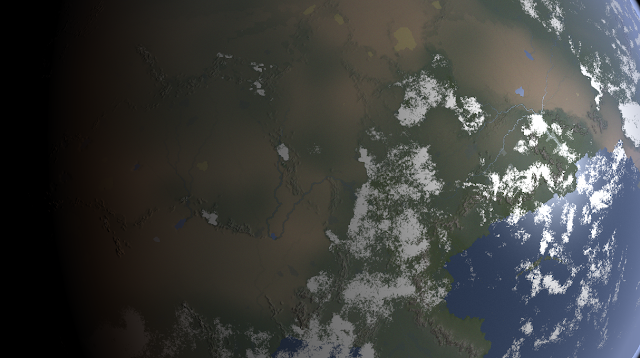I'm continuing with the process of converting the old region-drawing functions into the new globular context, and refactoring and improving them where possible.
While doing this I decided that the old way of tracking river flow wasn't accurate enough. At the moment, UW stores the January and July temperature and rainfall for every point on the global map. When needed, it can calculate the temperature and rainfall for other months by extrapolating them from that stored information (along with other relevant information such as the planet's obliquity, eccentricity, and so on). So far I've been doing the same thing with river flow: for every global cell, the program stores how much water is flowing in January and in July. The problem is that it's not possible to extrapolate the information for the other months from this information. This is because river flow is determined by more than just information about that point on the map. The water comes from elsewhere, and quite different climactic conditions might prevail in those other places. So we can't say (for example) that because there's less rain in March than in October there should be less river flow, because perhaps that isn't true of the place where most of the water is coming from.
So I've updated the program to track and store river flow for all twelve months. When the rivers are calculated, it goes through every cell on the globe and calculates how much water will be flowing for every month, and then adds that, month by month, to every downstream cell from that point. This means that the variation in flow can be shown quite accurately.
Here, for example, is a world with a very long river that travels through mostly desert and tundra:
(I've removed the clouds so it's easier to see.)
The information in the graphs to the top right are for a point on this river roughly in the middle of the image, where it passes through a pretty cold desert. There's significant variation in temperature, and no precipitation at all, but the river has a roughly constant flow throughout the year because its sources, far to the north, are in places with fairly even rainfall throughout the year.
Now compare this image:
You can see another large river which joins the first one near its southernmost point, in a darker area that indicates extensive wetlands. This river has its sources further south in the tundra and arctic mountains to the bottom right of the image. The graphs here are for a point on this new river near where it joins the first one. The temperatures and rainfall are similar to the previous one, but here you can see extreme variation in river flow: none at all for much of the year, and then a deluge in the brief summer as the snow melts in the sources of the river far to the southeast.
And, finally, we have this image:
This shows information for a point on the river near its mouth. Here, there is a bit more rainfall (not much!), but you can see that the variation in flow of the river follows an opposite pattern. For most of the year the river is moderately sized. This is the same flow that we saw in the first image. Then in the summer the river floods extensively, thanks to the meltwater coming from the second river that joined this one.
Since UW now displays variation in the seasons, the plan is that the sizes of rivers at the regional level will be shown dynamically, so you can see them swell and shrink as you move from month to month. Now that the program is storing flow information for every month, rivers like the one above should show this kind of variation in a way that adds a bit of believability to the simulation.




















